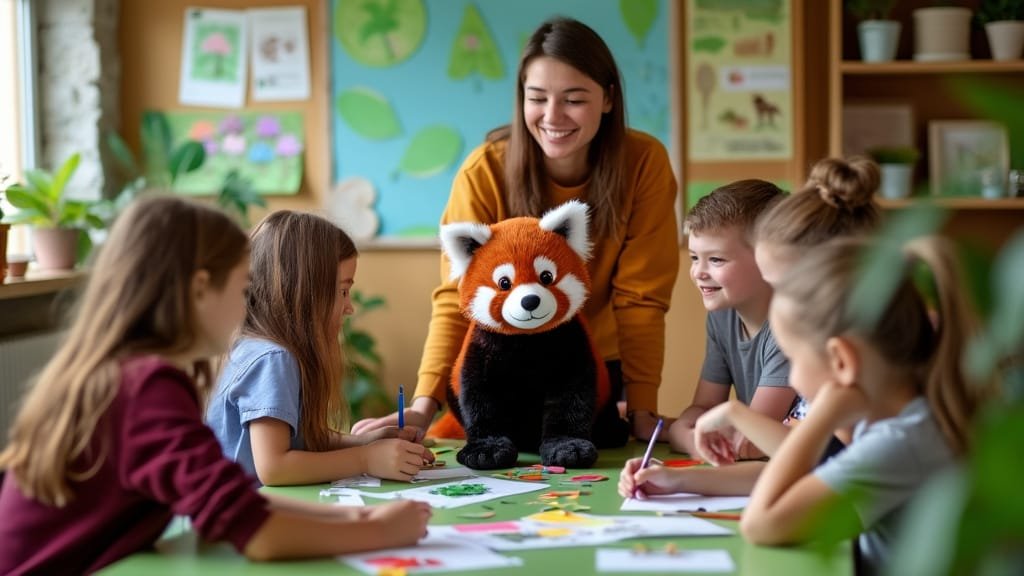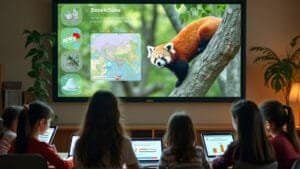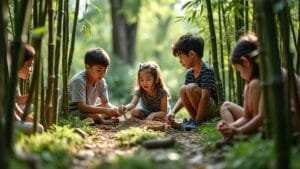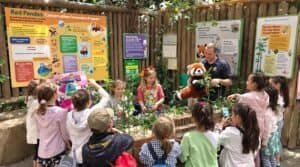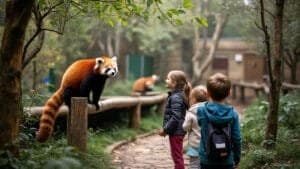Introduction
Teaching kids about red panda habitats can be both fun and educational with the right strategies. Children benefit from a mix of hands-on activities, visual aids, interactive games, and outdoor experiences that help them understand red pandas’ unique environments
By exploring Himalayan forest ecosystems, red panda behaviors, and conservation themes, these educational approaches foster an early appreciation for wildlife and environmental stewardship
This article provides key methods for introducing kids to red panda habitats in an engaging and age-appropriate way
Hands-On Activities for Learning About Red Panda Habitats
Hands-on activities are highly effective in teaching kids about red panda habitats, as they encourage active engagement and creativity
By building models, simulating ecosystems, and exploring natural elements, children gain a better understanding of the environmental factors that impact red pandas. These activities make learning memorable and help kids relate to the animals’ needs and surroundings
Habitat Model-Building and Dioramas
Creating habitat models or dioramas allows children to visualize the Himalayan forests where red pandas live. Using materials like clay, twigs, leaves, and miniature models of bamboo plants, kids can build a small-scale replica of a red panda’s habitat
This hands-on activity encourages kids to think about the elements that red pandas rely on, such as trees for climbing and bamboo for food, making the animal’s environment tangible and accessible
Teachers or facilitators can guide students by explaining each part of the habitat as they build it, reinforcing the connection between red pandas and their surroundings
Studies by Davidson (2022) have shown that model-building enhances children’s understanding of complex ecosystems, giving them a holistic view of red panda habitats and the importance of preserving these environments
Bamboo Planting and Forest Ecosystem Exploration
Bamboo, a primary food source for red pandas, provides an excellent starting point for teaching kids about red panda diets and habitat needs
By planting bamboo in a school garden or observing live bamboo plants, children can learn about the types of vegetation that make up red panda habitats. This activity can be expanded by creating a small “forest ecosystem” corner with other native Himalayan plants or tree species to mimic the diversity found in red panda habitats
Teachers can use bamboo planting as an opportunity to explain the red panda’s reliance on this resource and how deforestation threatens their survival
By observing plant growth and learning about sustainable gardening, kids understand the importance of preserving red panda habitats and the role that forest ecosystems play in supporting various species
Scavenger Hunts for Ecosystem Elements
Scavenger hunts focused on finding elements of a red panda habitat allow kids to connect with nature and learn about ecosystems interactively
In a classroom or outdoor setting, educators can hide items that represent parts of a red panda’s habitat, such as leaves, bamboo shoots, “climbing” structures (such as branches), and representations of natural hiding spots. As children search for these items, they learn about the components essential to a red panda’s habitat and the importance of each element for survival
This activity can be adapted to different age groups by incorporating educational clues or adding discussion breaks to explain each item’s significance
By actively searching for items, kids become more invested in learning about red panda habitats, turning an educational topic into an adventure that emphasizes both learning and environmental awareness
Using Visual Aids to Enhance Understanding
Visual aids help simplify complex concepts, making them accessible to young learners. By using maps, posters, videos, and interactive whiteboards, educators can illustrate the features of red panda habitats and the environmental factors affecting them
Visuals offer a clear and engaging way to convey information, allowing kids to grasp the essentials of red panda ecosystems quickly
Maps and Posters of Red Panda Habitats
Maps and posters depicting the Himalayan forests provide children with a visual understanding of red panda habitats. Maps can show the geographic range of red pandas across Nepal, Bhutan, and India, while posters highlight key features like bamboo forests, mountainous terrains, and rivers
Educators can point out each region’s characteristics, discussing how altitude, vegetation, and climate shape the environments where red pandas thrive
Posters illustrating red pandas’ physical features, diet, and behaviors further reinforce learning, offering detailed images that allow kids to recognize these animals’ unique adaptations
According to Chen and Liu (2020), children retain information better when presented through visual aids, making maps and posters valuable tools for enhancing learning and interest in red panda habitats
Educational Videos on Red Panda Ecosystems
Educational videos are another powerful tool for teaching kids about red pandas and their habitats. Many videos show red pandas in their natural environments, climbing trees, searching for food, and interacting with other wildlife
Watching these behaviors helps kids understand red pandas’ daily routines and how they depend on forest resources. Videos can also demonstrate environmental challenges, such as deforestation or climate change, making abstract issues more relatable for young viewers
For younger children, short, animated videos with simple explanations work well, while older students may benefit from documentaries that cover ecosystem dynamics in greater detail
By observing red pandas in motion, kids gain a realistic view of these animals’ lives, fostering empathy and a desire to protect their habitats
Interactive Whiteboards and Digital Illustrations
Interactive whiteboards and digital illustrations allow educators to create dynamic lessons that engage students through visuals
Teachers can use these tools to show detailed images of red panda habitats, highlight features like bamboo groves and tree cover, or zoom in on specific habitat components. Interactive whiteboards also allow for quizzes, drag-and-drop activities, and drawings, which help reinforce concepts in an interactive manner
Digital illustrations of food webs, forest ecosystems, and red panda anatomy provide a close-up look at the animal’s place in its environment. These illustrations can be displayed on smartboards or tablets, encouraging kids to interact with the content by pointing out the red panda’s needs and the factors that make up a healthy habitat
By combining interaction with visuals, digital tools make it easier for kids to understand red panda habitats and the ecological balance they rely on
Interactive Games and Role-Playing Exercises
Interactive games and role-playing exercises are effective tools for teaching kids about red panda habitats, as they combine learning with hands-on, immersive activities
By engaging children in simulations, role-playing, and ecosystem-based challenges, educators can create memorable learning experiences that teach students about the importance of habitat preservation and the behaviors that support red panda survival
Habitat Simulation Games
Habitat simulation games provide kids with a fun way to learn about the red panda’s environment by allowing them to “build” and manage a virtual ecosystem
These games often include tasks like planting bamboo, creating safe hiding spots, and adding climbing structures to mimic the red panda’s natural surroundings. Some educational apps and online games offer red panda habitat simulations, where kids can explore concepts like resource availability and balance within the ecosystem
Instructors can guide students through these simulations by discussing the elements needed for a healthy habitat and the challenges red pandas face in the wild
By completing tasks and solving challenges in the game, children develop a deeper understanding of the complexity of red panda ecosystems and the need to protect natural resources
Red Panda Role-Playing and Survival Activities
Role-playing exercises allow kids to “become” red pandas, exploring their behaviors, diet, and survival strategies in a hands-on way
In a classroom or outdoor setting, kids can act out the daily routines of a red panda, such as climbing, searching for bamboo, or avoiding imaginary predators. This activity encourages kids to think about the red panda’s needs and how the animal interacts with its environment
Teachers can add educational elements to these exercises by explaining red panda behaviors and why they perform certain actions, such as climbing trees to avoid predators or seeking bamboo in particular areas
Role-playing helps kids empathize with red pandas, reinforcing the idea that habitat protection is essential for their survival
Ecosystem Balancing Challenges
Ecosystem balancing challenges are interactive games where kids work to create and maintain a balanced habitat for red pandas
In these challenges, kids may need to add or adjust elements like food sources, shelter, and safe zones to ensure the habitat remains healthy. This activity illustrates the importance of each component in an ecosystem, showing how changes in one area can impact red pandas and other species
Teachers can use balancing challenges to discuss real-world issues like deforestation, climate change, and resource management, showing kids how these factors affect red panda habitats
This hands-on approach helps children understand the delicate balance within ecosystems and the role conservation plays in protecting red panda populations
Outdoor Learning and Nature-Based Activities
Outdoor learning activities offer kids a firsthand experience with nature, helping them understand red panda habitats through direct engagement with the environment
These activities encourage exploration, observation, and a sense of wonder for wildlife, making the concept of habitat conservation tangible. Through guided nature walks, storytelling sessions, and building mini-habitats, kids develop a deeper connection to nature and an appreciation for the ecosystems that red pandas depend on
Guided Nature Walks and Habitat Exploration
Guided nature walks allow kids to experience a version of a red panda’s habitat by observing local plants, trees, and other elements of a forest ecosystem
Educators can point out plants that are similar to those found in red panda habitats, such as bamboo or other dense vegetation, and explain their importance to the ecosystem. During the walk, kids can learn about animal adaptations, food sources, and the role of forests in supporting biodiversity
These walks also provide an opportunity to discuss the impact of habitat loss and ways to protect forest ecosystems. By exploring nature up close, kids can better understand the importance of preserving habitats like those of the red panda, reinforcing lessons on environmental stewardship
Outdoor Red Panda-Themed Storytelling Sessions
Storytelling is a powerful way to engage kids, and holding red panda-themed storytelling sessions outdoors brings the story to life
Teachers or facilitators can share folktales from Himalayan cultures that feature red pandas or create stories that highlight red panda behavior and habitat needs. These storytelling sessions help kids relate to red pandas on an emotional level, making it easier for them to understand the importance of conservation
Outdoor storytelling also encourages kids to connect with nature as they listen, surrounded by the sounds and sights of the environment
By weaving in lessons about habitat preservation and environmental responsibility, educators can use storytelling to inspire a sense of responsibility for protecting species like the red panda
Mini-Habitat Building with Natural Materials
Building mini-habitats using natural materials allows kids to explore ecosystem dynamics creatively. By collecting twigs, leaves, stones, and other outdoor materials, children can construct a small habitat model that resembles the red panda’s natural environment
This activity teaches kids about the elements needed for a balanced habitat, such as food sources, shelter, and safe spaces
Educators can guide discussions on how each item contributes to the habitat, helping kids understand the interconnectedness of an ecosystem. Mini-habitat building encourages creativity, teamwork, and problem-solving, and it provides kids with a memorable, hands-on learning experience that highlights the importance of preserving natural habitats for red pandas and other wildlife
Conclusion
Teaching kids about red panda habitats is most effective when approached through engaging and interactive strategies that foster a sense of connection to nature
Hands-on activities like model-building, habitat simulations, and nature-based storytelling allow children to visualize and better understand the complexities of red panda ecosystems
By using visual aids, interactive games, and outdoor learning, educators can make the learning process both fun and meaningful, helping kids appreciate the red panda’s unique environment and the importance of conservation
These educational strategies not only enhance children’s understanding of red panda habitats but also instill a sense of environmental stewardship that can last a lifetime. By connecting kids with the natural world, these approaches encourage them to protect endangered species and advocate for the preservation of forests and wildlife
Through immersive experiences, we can inspire a new generation of conservation-minded individuals who understand the critical role each species plays within the ecosystem
